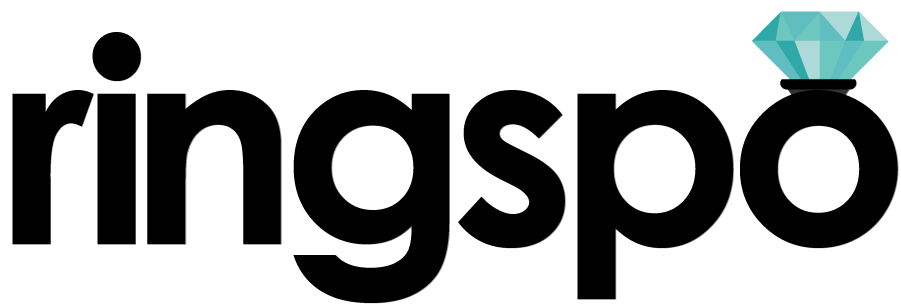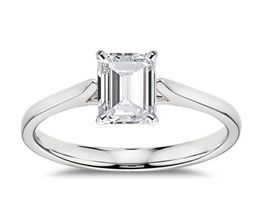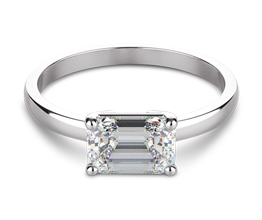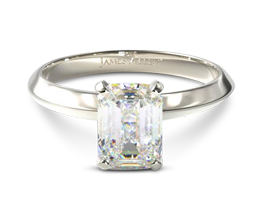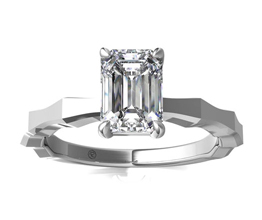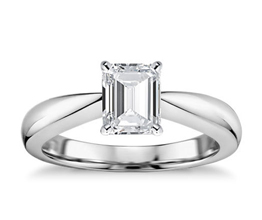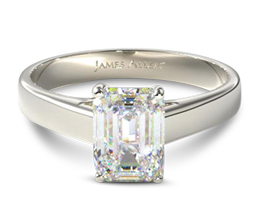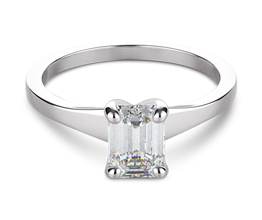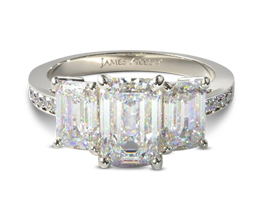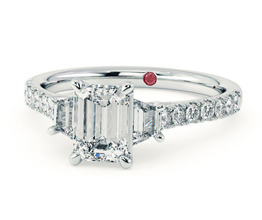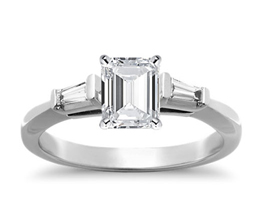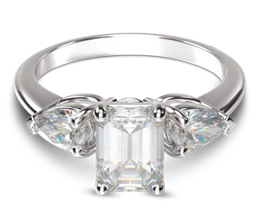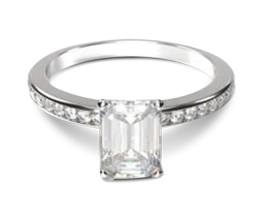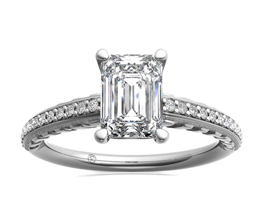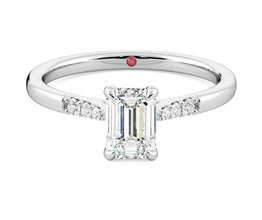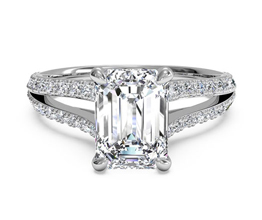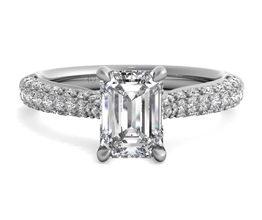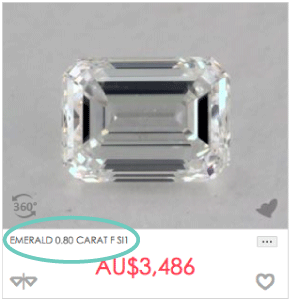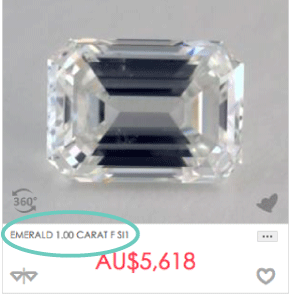Emerald cut engagement rings
How to get the most beautiful emerald cut diamond and the most value
Ringspo is reader supported
Ringspo is reader-supported, which means we may receive a commission if you click a link to a retailer & subsequently make a purchase.
We feature links to several retailers to help readers find the one that is the best fit for them. Find out more about how Ringspo works here.
Emerald cut diamond engagement rings make a slightly unusual, but very elegant and classy alternative. With a look that complements vintage-style ring settings, the emerald cut diamond is perfect for someone who values old-school glamour, rather than flashy bling.
We’re going to look at:
- What’s good about emerald cut engagement rings
- What’s bad about emerald cut engagement rings
- Emerald cut engagement ring setting styles
- An emerald cut diamond guide
- Recommended specs
Do you know about the 4Cs?
Much of the information on this page will focus on diamonds, as getting that right is key to getting an awesome ring for a great price. If you’re not familiar with the 4Cs of diamonds then I’d recommend reading this page which gives an overview of what you really need to know.
The defining feature of the emerald cut is the ‘stepped’ nature of the pavilion – the bottom half of the stone, marked P on the diagram on the right.
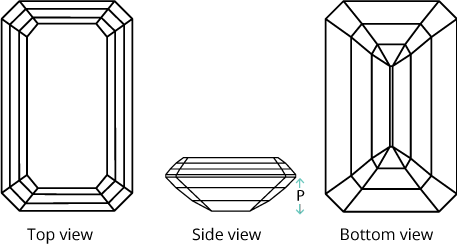
The stepped facets give the emerald cut a much more regular and geometric look than other diamond shapes which have facets angled in many different directions. This results in emerald cut stones catching the light in big bright flashes as the light bounces off the large facets, rather than the gentle sparkle of a brilliant cut diamond like the princess cut, where the light is reflected off the smaller facets at different times.
The shape used in Emerald cut engagement rings was, unsurprisingly, originally created for emeralds, rather than diamonds, and it’s still the most popular shape for emeralds today.
The shape was originally developed because emeralds are relatively soft, for a precious stone. The straight facets are easier to trim without damaging the stone and the squared off corners trimmed corners reduce the risk of the stone getting damaged.
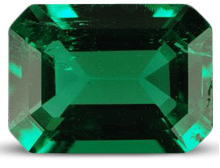
Diamonds are much harder than emerald, so it’s not because of the stones fragility that the emerald cut is used.
Instead, the emerald cut diamond originally became popular in the art deco period, when geometric shapes and elegant lines were in fashion – a perfect match for the straight lines of the emerald cut. Although not nearly as popular today, emerald cut engagement rings still exude the elegance and glamour from the bygone art deco period.
What’s good about emerald cut engagement rings?
Emerald cut diamonds are well-priced
For a couple of reasons, emerald cut engagement rings are considerably less expensive than the more popular cuts. The first reasons is just that – because there is lower demand for them, jewelers know that they need to price emerald cuts lower.
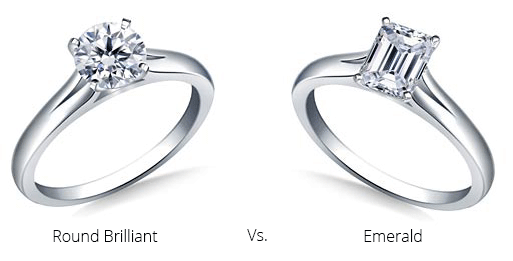
But emerald cuts are also easier to make than brilliant cuts like the round or the princess cut. This means that a less skilful gem-cutter is needed to create them and they take less time to cut and shape. These savings can then be passed on to the end consumer.. You!
The table below shows the price difference from one of our recommended retailers between a round brilliant diamond, the most common shape and an emerald cut diamond of the same size and quality:
- 1 carat
- Color F
- Clarity VS1
Here’s how they compare:
| SHAPE | PRICE (US$) | DIFFERENCE (US$) | DIFFERENCE (%) |
|---|---|---|---|
| Round Brilliant | 6,610 | ||
| Emerald | 4,152 | -2,458 | -37.2 |
There’s a massive 37% saving to be had by choosing a different shape to the most popular shape. The actual saving that you could make will depend on the carat, cut and clarity of the stone that you’re looking at, but there will always be a considerable price saving to be made.
Emerald cut diamonds look large
Emerald cut stones are usually shallower than brilliant cut stones, which means that less of the stone is hidden in the mounting of the ring, and more of it is visible. This, together with the elongated shape contributes to making the stone look larger than many other diamond shapes at the same carat weight.
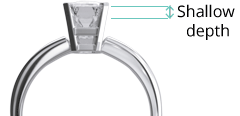
Emerald cut diamonds are flexible
Emerald cut diamond engagement rings are also flexible with who they suit. Their rectangular shape means that they can be cut to be shorter and more square, which flatters longer fingers, or they can be cut to be more rectangular, which elongate and look good on shorter fingers. There will be a shape that works for everyone.
Emerald cut diamonds are practical
Lastly, the lack of sharp points on the corners means that emerald cut diamond engagement rings are unlikely to get snagged on clothes or hair, as some other shapes can.
What’s bad about emerald cut engagement rings?
While other shapes of diamond are cut with their proportions specifically calculated to reflect as much light and sparkle as much as possible, the long, straight facets of the emerald shape don’t work in quite the same way.
This has a couple of effects:
Emerald cut diamonds need higher clarity
The main negative about the emerald cut is that a higher quality stone is required than with ‘brilliant cut’ diamonds.
The large top table (flat area on the top of the stone) means that inclusions, scratches and other impurities can be seen more easily. The diamond on the right has a clarity grade of ‘SI1’ (Slightly Included 1) and very obvious inclusions.
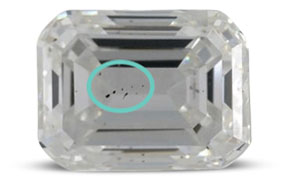
With some other shapes, most SI1 diamonds are ‘eye-clean’ ie. they look perfect when examined with the naked eye and flaws can only be seen by using a microscope. All SI1 emerald cut diamonds need to be examined to check that flaws aren’t visible and buyers often need to go for a higher clarity grade to get an eye-clean stone.
Emerald cut diamonds are less brilliant
While ‘brilliant cut’ stones like the round or Princess cut have ‘brilliance’ and ‘fire’ in their sparkle as light bounces around the inside of the diamond and back to your eyes, emerald cuts reflect light in a different way.
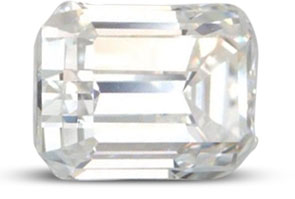
Emerald cut diamond’s long, flat facets reflect light off the surface of the stone, which means that instead of a sparkle, the produce flashes of light that either appear ‘on’ or ‘off’. If you’re looking for an engagement ring with a high amount of sparkle and bling, then the emerald shape is probably not for you.
Emerald cut engagement ring settings
Choosing the shape of the stone for your engagement ring is a big decision, but selecting the setting style will have just as much of an effect on the visual impact.
There are a range of classic ring settings that have become classics for a reason – they look great and they’re not subject to the whims of fashion. I’ve listed a selection of classic styles below, but the list certainly isn’t definitive.
If you see a setting style that you like, click through to find out more about it.
Emerald cut diamond solitaire engagement rings
The classic setting that flatters an emerald shape stone the most is a basic 4 prong solitaire. It allows the maximum amount of light to enter and reflect off the stone, as well as holding the stone securely at the 4 corners. Due to their simplicity, solitaire settings are also always the most cost effective setting style.
Scroll across to check out a selection of emerald cut solitaire engagement ring options, and click through to find out more about each one.
Emerald cut diamond three stone engagement rings
Adding side stones to emerald rings originally because popular in the art deco period. Smaller side stones add more carat weight, without the associated cost of increasing the center stone. With the side stones placed at a different angle to the center stone, they will also catch the light and flash and sparkle at different times to the main stone – increasing the ring’s impressiveness.
Emerald cut diamond pavé rings
A much more modern approach to supporting diamonds is a pavé setting, where a large number of small ‘melee’ diamonds are set into the band. A large number of brilliant-cut diamonds is an interesting juxtaposition to the step cut emerald diamond, which delivers the best of both worlds – brilliant sparkle from the round diamonds and blinding flashes from the emerald shaped diamond itself.
Emerald cut diamond buying guide
Although increasing in popularity, emerald cuts aren’t widely available in large numbers in bricks and mortar stores and unfortunately it’s unlikely that you will be able to find a good selection in jewelers near to you. Online jewelers do have an excellent selection though, and our diamond finder will help you find the exact stone you’re looking for at the lowest price.
In this section we’ll look at what you really need to know to make sure that you get a great emerald cut diamond to ensure that your engagement ring is perfect. It will get a little bit technical, but I’ll include all the recommendations in a separate section at the end too.
Emerald cut diamond clarity
Brilliant cut diamonds, like the princess cut, ‘chop up’ the light entering and exiting a diamond. The light goes in, bounces around and then exits the stone with range of sparkles and fiery colours, which all help to hide any minor imperfections that may be lurking in the stone.
However, emerald cuts don’t have this luxury. Emerald cuts’ large top table acts like a window straight into the stone and minor flaws that would be invisible with other shapes are much more easily visible with emerald shaped engagement rings.
Our recommendation is to go for a VS2 clarity grade as a minimum, to ensure that your stone is ‘eye clean’, with no imperfections visible to the naked eye. If you are thinking of going lower than VS2 clarity then I’d definitely recommend that you use a diamond retailer that offers high quality magnified images of the actual stone that you are considering e.g. James Allen or Blue Nile.
They’ll allow you to assess any flaws and ensure that it’s not in the center of the stone and ensure that they are not visible.
Emerald cut diamond color
The lack of sparkle on emerald cuts also affects my recommendation for colour. Without the brilliance and fire to distract, the true color of the stone is more easily seen than brilliant cut shapes. We therefore recommend going with G as the minimum colour grade.
Going higher than this may give you a slight benefit, but at the highest end of the colour range you are paying for the ability to say that you have a D colour (the highest) stone, rather than any actual improvement in appearance.
If you go lower than G then you are likely to see some warmer tones coming through in the color.
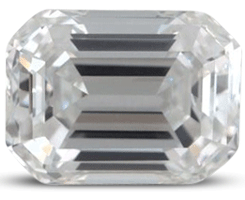
Color E – colourless, but very expensive
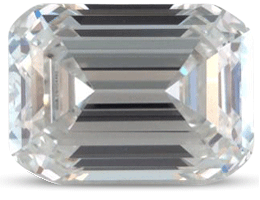
Color G – a good mix of white colour and good value
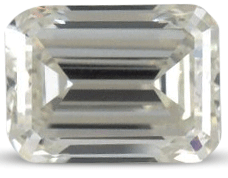
Color I – warmer yellow tones clearly visible
Emerald cut diamond cut quality
Unlike some other diamond shapes, there are no set guidelines for what constitutes an ‘ideal’ emerald cut diamond. However, there are definitely some considerations that you should take into account when choosing your stone.
Emerald Cut Diamond Length / Width ratio
The classic emerald shape has a width/length of 1:1.5, which means that it is twice as long as it is wide. Emerald L/W ratios can vary though – with anywhere from 1.2 to 1.7 being common. One ratio is not necessarily better than the other and which shapes you go for depends on personal preference.
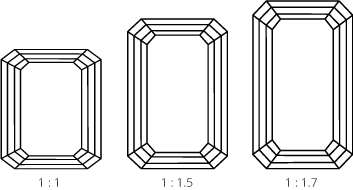
These examples show you a range of L/W ratios, but check out a few pictures of diamonds from jewelers and see what you like the look of.
One thing I’ll mention again is that shorter emeralds tend to look better on longer fingers, while longer emeralds can have a positive elongating effect on shorter fingers.
Emerald Cut Diamond Depth Percentage
The depth % is the depth of the stone calculated as a percentage of the width. For some stones this is extremely important as certain proportions are required to ensure the stone reflects light internally and back to the viewer’s eye.
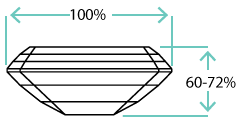
For emerald cut stones this is less important, but the following ratios are a good guide to balance the visible size of the stone with light performance:
| Excellent | Very good | Good |
|---|---|---|
| 60% – 72% | 56% – 76% | 54% – 78% |
Table Percentage
Table percentage is the width of the top ‘table’ of the stone expressed as a percentage of the total width of the stone.
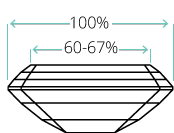
For emerald cut diamonds, the table percentage should always be lower than the depth percentage.
| Excellent | Very good | Good |
|---|---|---|
| 60% – 72% | 55% – 74% | 50% – 76% |
Polish
Much of the shine from emerald-cut diamond rings comes from the light reflecting directly back off the surface of the stone. To maximise this, we recommend choosing a stone with as high a degree of ‘polish’ as possible – ideally ‘excellent’.
A stone with a high polish grade will have a smooth surface with very few, if any, imperfections. Any imperfections on the surface of the stone will mean that it reflects less light, which means that it will sparkle less brightly.
Emerald Cut Diamonds and Carat Weight
Carat weight is something that people often get overly hung-up on. They want to choose a stone with a certain carat weight, even if it means that they end up making sacrifices on other, more important attributes of the ring.
The relationship between a diamond’s carat weight and its visible size isn’t always a direct one. When we judge a diamond’s size, we look at it from the top – known as the ‘face up’ position in the jewelry trade. However, much of the weight of a diamond is actually carried on the bottom half of the stone, where it can’t be seen.
The images below show the difference in size for emerald cut diamonds at a range of carat weights:
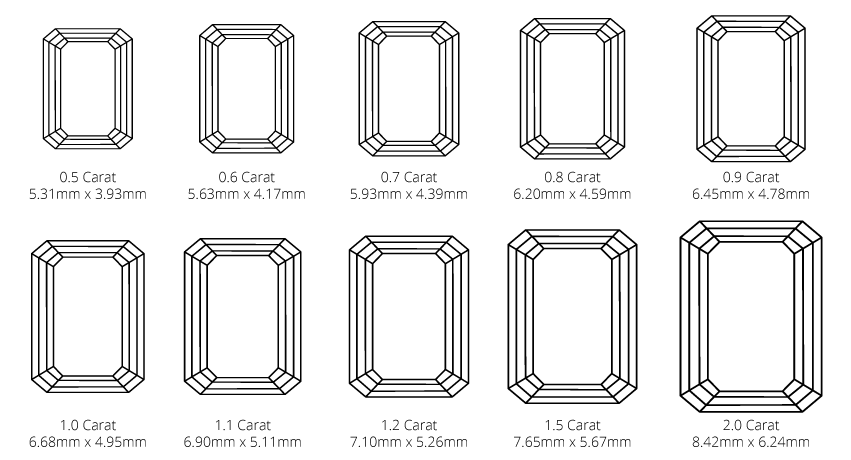
Hopefully you can see that increasing the carat weight doesn’t necessarily translate into a much visibly larger diamond. Changing the size from 0.8 carat to 1 carat is an increase in width of less than 0.4mm – less than 10%. However, the difference in price will be much more significant – about a 60% increase:
The priority that you place on diamond carat weight and how bit you want to go is totally up to you. However, my recommendation is that you definitely don’t make it the most important attribute when choosing your engagement ring. Get the setting you love, find a diamond with a great cut that is going to sparkle brilliantly, make sure that it is eye-clean and has a good color and then see what carat weight you can fit into your budget.
A well-rounded diamond with excellent sparkle will much much more impressive than a big stone with obvious flaws.
Emerald Cut Diamonds and Certification
Certification is the unofficial fifth C, but a very important one.
When looking at any diamond, you need to ensure that any diamond that you’re looking at is a ‘cert stone’, which means that it has been assessed, graded and coded with a laser by an independent lab.
Each certificate has a unique report number and detailed information about the stone, covering the four Cs, the height, depth and other info. As well as providing assurance that the stone that you’re buying is the quality that you are paying for, a certificate also proves what you’re buying is not a substitute.
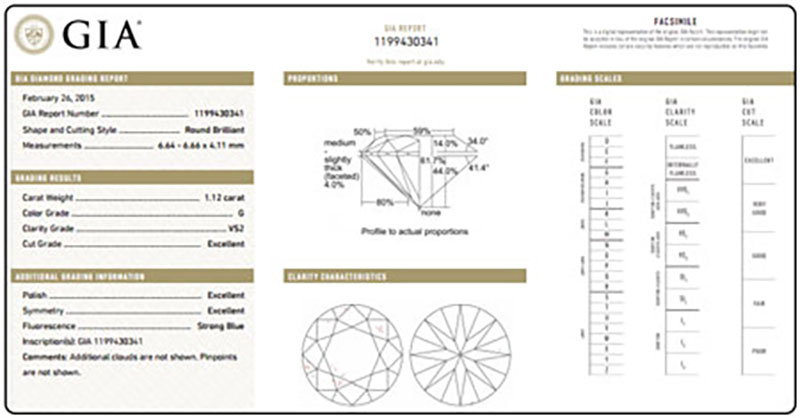
The lab to trust and to look for certification from is the non-profit Gemological Institute of America (GIA). It’s the most internationally recognised and generally seen as the most impartial of all of the gem labs.
The reason that the GIA is so well respected is because most others labs are part of trade bodies that contain jewelry retailers, or are ‘for profit’. While the GIA is very consistent with its gradings, the others have a reputation for being overly generous. What the GIA say is merely a diamond with a ‘good’ cut, maybe be graded ‘excellent’ by another lab, with an excellently large price to match.
Diamond certificates are what makes buying online safe and the best way to get a fantastic diamond at the lowest price. Knowing that each diamond you’re considering has been measured and graded by independent experts allows you to make an informed decision. You can take your time to consider the differences between diamonds and make sure you choose what experts have graded as the best stone, meaning that you get your perfect engagement ring at the best possible price.
Emerald Cut Diamond Recommended specs
hese specs are the minimum that we recommend to ensure that the diamond on your emerald cut engagement ring looks fantastic.
You can of course go higher than these specs, if your budget allows, but for many of the characteristics you are paying for improvements that are very difficult, if not impossible, to see by the naked eye, especially when mounted in a ring setting.
If you’re unsure about what any of these terms mean, check out this page which talks you through them all.
| Clarity | VS2 |
| Colour | G |
| Cut | Very Good |
| Polish | Excellent |
| L/W ratio | 1.35 – 1.55 |
| Table % | 60% – 72% |
| Depth % | 60% – 72% |
